Parma is in the northern region of Emila-Romangna, in Italy. It has a population of close to 200,000. Bologna is the capital city of the region and is 98km south of Parma. Parma is known around the world for Parma Ham (Prosciutto) and Parmesan cheese.
I arrived on a train from Milan which took 47 minutes. A first class ticket cost €29.90. You get a reserved seat in a first class carriage and there is always room for luggage. I returned on a different train, which took 95 minutes and a first class ticket cost €13.00. Apart from the duration, the only difference was I was served beverages and a snack at my seat on the outbound journey. While it was lovely (water, coffee and brioche) the price differential wasn’t worth it.
Parma is an extremely easy city to walk around and find your bearings. Most of the city center is pedestrianised with cobbled streets. There are yellow signs, in Italian and English, at every attraction. There is also a very interesting guide to key monuments. They are numbered 1-16 and using a QRD code you can get an overview of each historical figure portrayed.



Borgo Tommasini, a short walk from the center, has lots of mirrors hanging overhead. The adjacent streets all have interesting pictures displayed at the entrance.

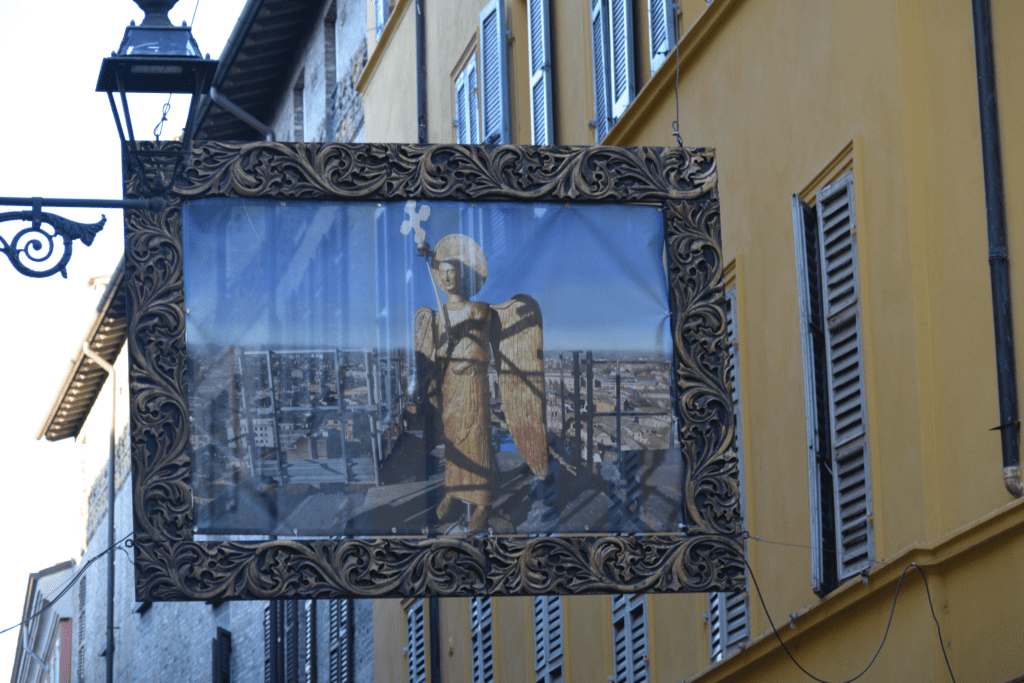
I spent 3 days wandering around this beautiful city and the following is what I saw and did.
La Nuova Pilotta
This building is huge but quite austere on the outside. You purchase a ticket at the office on the right hand side (€18.00 for an adult ticket) and then walk to the opposite door. I wasn’t quite sure what to expect as I hadn’t done any research on this. I thought it was expensive in comparison to other Italian attractions. But what a treat I was in for and I soon realised why it was expensive.
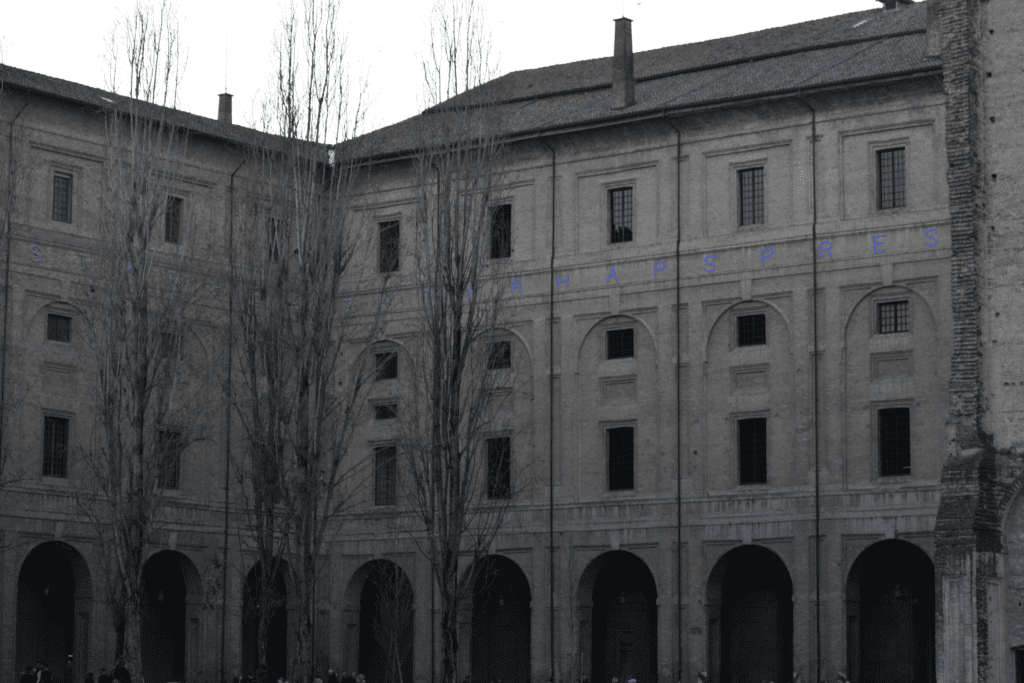
I went to the “Bibliotecca Palatina” first. This long library contains over 860,000 books. They are stored on shelves from floor to ceiling. It’s a really fascinating library and the titles you can read are in different languages and date back several centuries. I was there alone and the two invigilators seemed only too happy to answer my few questions. They were clearly extremely proud of this fascinating library. They told me every book gets dusted every two years and a less intensive clean occurs annually.


I then went through a large and extremely ornate door. The invigilator stationed at the door was speaking to several people as they were leaving quicker than she expected them to. I was intrigued straight away. The first room had lots of signs giving an overview on the history of “Teatro Farnese”. It’s an actual wooden auditorium contained within the building. It was constructed between 1893 and 1897. I thought it looked like an indoor Colosseum. It is one of the most impressive interiors I have seen anywhere in the World. The circular viewing areas contain rows of benches. Above them there are two levels of boxed seats with beautiful arches. Every twenty minutes (from 10.40-18.60) a 3 minute video played over the stage area showing some of the shows that have been performed here. It’s very well done with great acoustics and the visuals are excellent. It’s quite strange standing on the floor listening and watching shows which happened hundreds of years ago.

You then continue through a narrow hallway (I realised why people were walking out and missing it), which takes you through to the “Galleria Nationale”. This originally was the stables and barns of the building. The restoration is amazing with its exposed brick walls, iron railings, cement floors and staircases. It’s a very clever use of space as artwork and artefacts are showcased in long rooms and small coloured walled spaces. One of the main rooms has a large marble topped table in the center displaying hundreds of artefacts. They are all just on top of it and are not behind a glass screen. You walk through the various rooms, go up and down stairs to see the exhibits. The signage is very good and you get a great overview of the exhibitions. The artwork is from a range of both local and International artists. Some of it is religious and there are also lots of portraits of the main figures of the Duchy which lived in Parma over the years. I have been to lots of museums in Italy and the artwork here was by artists I am not familiar with. However their names are very familiar in Italian culture. These include Bellini, de Grano, Parmigianino and Peroni !!!


You then arrive at the “Medagliere Bordoniep” which is an exhibition of coins and medals. They date back several centuries.
The “Archelogico Museum” is on the ground floor and the first thing you see are very distinctive columns which were recovered from the PO river in 1178. The rest of the museum is arranged per “age” and has artefacts from the copper and iron ages. They include household items, jewellery and ornaments.

You really need 2-3 hours to see everything this amazing museum has to offer. It really is multiple museums in one and well worth the entrance fee. There are seats where you can rest along the way and there are toilet facilities on each floor.
Cathedral Square
This cobbled square is surrounded by picturesque buildings. The “Cathedral of Santa Maria Assunta” is straight ahead and you can enter it free of charge. There are beautiful private chapels and prayer areas along the side. Elaborate frescos are displayed on all the ceilings. There is an impressive black and gold pulpit half way along the main area. A beautiful organ is at the right hand side of the altar. You can light an electronic candle and leave an offering.

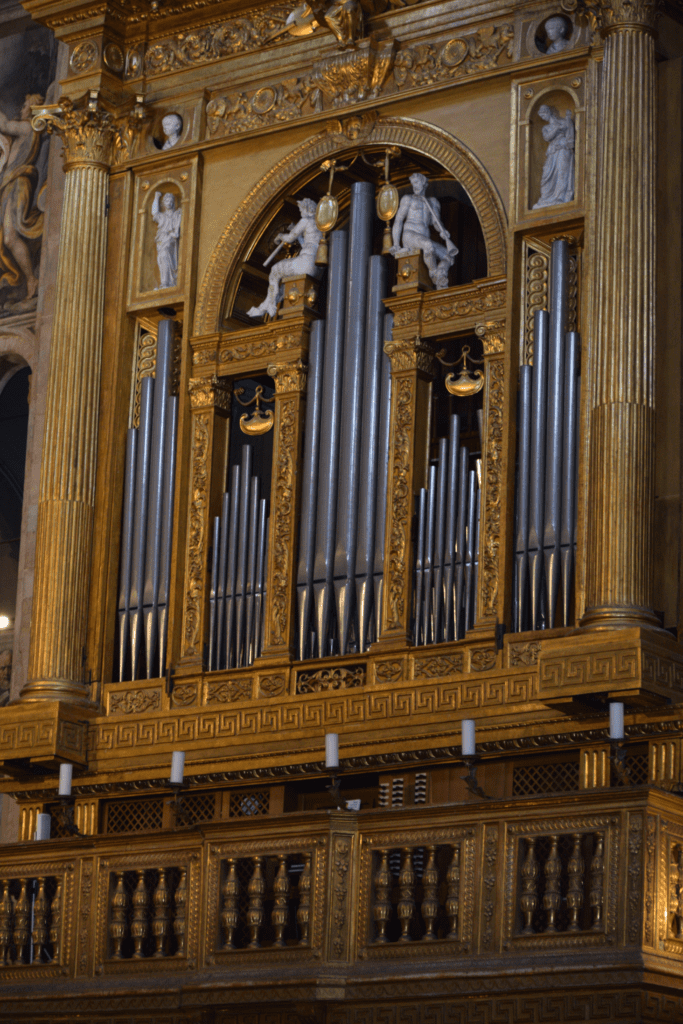
Across from the Cathedral is the ticket office where you purchase a ticket to enter the other buildings. The adult admission costs €12 and I was given a pamphlet in Italian. I went to the “Museo Diocesano” next. After seeing some of the original stonework, I came to a TV screen which had an excellent video in Italian, subtitled in English. I was glad I stopped to watch it as I don’t think I would have understood the displays i would later see, without this. The video is constantly played so you can start watching at any time. The Museum contains lots of statues of historical figures including one of the Queen of Sheba. Six slabs of stonework are displayed on the left hand side. They are in various colours including one in Verona Pink.
After leaving the Museum I then went to the distinctive pink octagonal building to the left of the Cathedral. This is the “Battistero” translated to Baptistery and is where people were baptised. The exterior is made from Verona pink stonework.

Inside there is a huge marble pick baptismal fountain which looked large enough for an adult to get into. There are lots of statutes around the sides. The first batch all symbolise the months of the year and the zodiac signs. These had been explained in the video I saw earlier so I was delighted to see them. The one for my birth month and sign symbolises a peasant digging turnips which amused me ! On the left side are two pieces of artwork depicting Winter and Spring. Ones for Summer and Autumn were never created. The roof is extremely intricate and I was glad a sign explained each area. The frescoes were completed between 1260 and 1270 and each area symbolises something different. I did wonder if originally people could go up to the higher balconies but I couldn’t see a stairway or any ladder which would allow that.

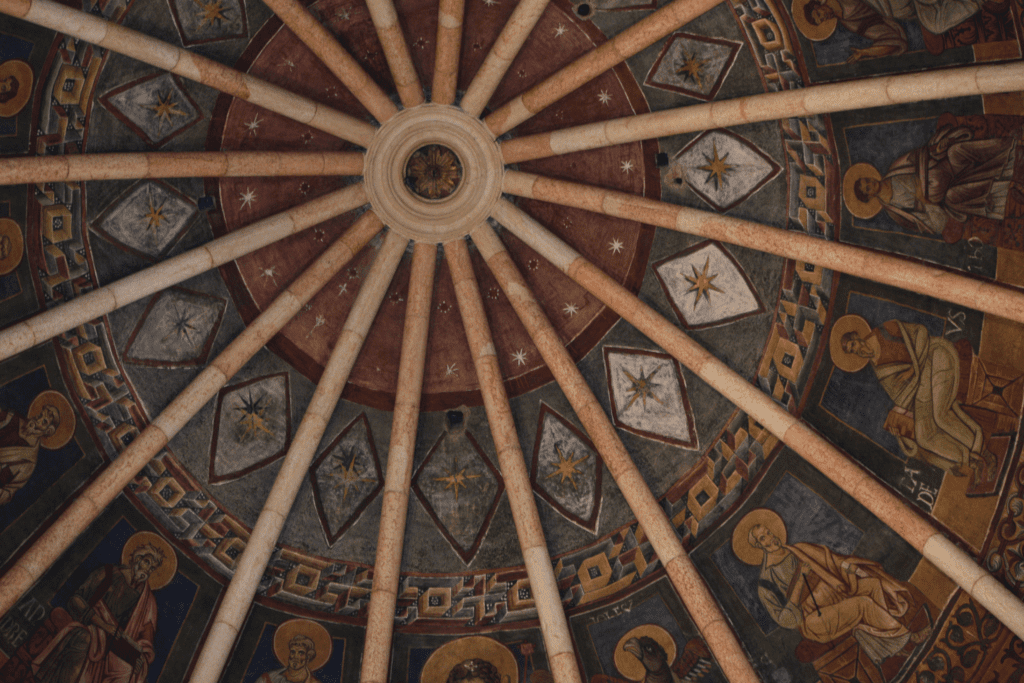
Opera House
I next visited the Opera House. I had gone in earlier and booked an English tour for later in the day. It cost €7.00 and I was told to return 10 minutes before it started. When I returned there were several tour groups waiting for guides. Tours were also available in German, French and of course Italian.
The tour guide took our small group into the theatre and down towards the stage. When we had all seated she gave us a very detailed and engaging history of the Opera House. The interior was originally blue and it was repainted in red and gold in 1859. The interior is now very similar to La Scala in Milan. The theatre is 194 years old and several of the great composers and conductors have performed here. Bellini premiered a new opera to open the theatre. However, it was not well received by the audience. It’s normal, even today, for audiences in Parma to boo and make their feelings known. It is deemed a difficult theatre to perform in as locals consider themselves opera aficionados.


The capacity is currently 1,200 and it previously was 2,000 as there originally was lots of standing room. Or you could bring a folding chair. There are four levels of boxes and the Royal box faces the stage. The guide explained that previously the boxes were privately owned and it was considered very prestigious to own one. Some are still privately owned by wealthy families. Even when you own a box, you purchase a ticket for a show. When the owners are not using them, they do allow the theatre to sell tickets for the boxes. We then went up to the Royal box, which has 14 seats. The guide explained that patrons would often rent a private room in the theatre and have a meal before a performance. They would either bring in their own food or have the theatre cater it for them. This is a little like “tailgating” in the US – just Italian opera style !!
The stage is 35m by 30m by 25m high. It is tilted slightly to allow a great view from all areas of the theatre. The orchestra pit is 3m lower than the stage. The current chandelier is beautiful and is 3m by 2m. It is moved up and down by a machine for cleaning and to replace the bulbs. I really enjoyed this visit and even if you are not an opera lover, it’s a fascinating building to visit and learn about its history. As is normal in Italy, the guide said her goodbyes and left quickly so didn’t expect tips.
Santa Maria delle Steccata
This church is just across from the Opera House. You can visit free of charge. Just like in the Cathedral, the beautiful organ is at the side of the altar. The altar contains quite dark artwork and statues. It had a pink marble pulpit to the right of the altar. This church also had electronic candles you could light, paying a donation.



Camera de San Paola
The entrance fee is €8.00. The first thing you see is a painting of “The Last Supper”. While I have seen Leonardo di Vinci’s painting, this is also amazing and covers the full length of the wall. There are lots of other paintings displayed on slabs and while some are damaged, all are interesting. The frescoes on the ceiling do rival Michaelangelos in the Sistine Chapel. There are also lots of beautiful gold artifacts displayed throughout this museum.
The Puppet Museum
When you exit the building, there is a door advertising a free “Puppet Museum”. It really is quite a delight and contains puppets of various sizes dating back to the nineteenth century. They also had some of the original posters for the performances. Signs (in 4 languages) explain the history of puppetry in Italy and the global stars who have performed with them. These include Charlie Chaplin and Josephine Baker. I think some of these puppets must have inspired the modern puppeteers like Jim Henson. This is quite a little gem to visit and suitable for all ages.
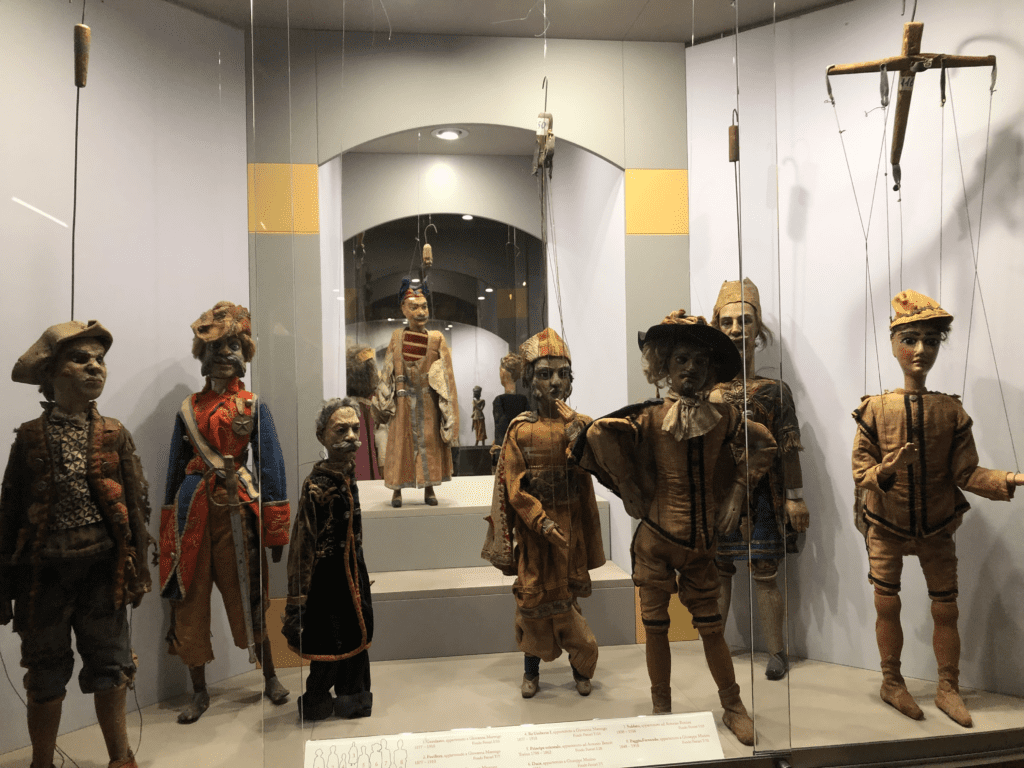

Zebre Parma, Rugby Team
Zebre Parma is the local rugby union team. They play in the United Rugby Championship (URC). This is a club tournament with teams from Ireland, France, South Africa and Italy. Zebre is one of the two Italian teams which play in this, the other is Benetton Treviso (see post on Treviso, another great small Italian city to visit).
Zebre play at Stadia Sergio Lanfranchi. Their strip is dark blue with a yellow stripe on the sleeve and on the shorts. The stadium has a capacity of 5,000 and was renovated in 2008. You can walk from the train station to the stadium, through commercial and residential areas. I walked there and back, including late (after a 20.30 KO) and it’s an extremely safe area. It takes about 30 minutes from the train station and 40 minutes from the city center.
The stadium has two stands on either side of the pitch. There are several bars and cafes within the grounds. The toilet facilities are minimal though. There were just two unisex toilets near the west stand where I was sitting.
Just like at Treviso, the Parma supporters are vocal and passionate in their support for Zebre. The atmosphere is really great and I found everyone very friendly, when I went to support my home provincial team of Leinster.


Rugby fans travelling from overseas can fly into one of the following airports:
Milan Airport(s) (has three airports Malpensa, Linate and Bergamo)
- All three have flights from several European cities from all the well known airlines
- All three have connections to Milan Centrale train Station (bus or train)
- Trains from Milan Centrale take 47 minutes to get to Parma and trains go frequently
Bologna Airport (Bologna Guglielmo Marconi Airport)
- Has flights to and from several European cities from all the well known airlines
- The airport is connected to Bologna central train station via a Monorail, which takes 7.5 minutes
- Trains between Bologna train station and Parma train station take 49 minutes and trains go frequently
- There is also a bus connection which departs fives times a day but trains are more frequent
Pama has a small airport (also known as Guiseppe Verdi Airport) but it has minimal flight connections. They mainly fly to and from Sardinia, Sicily and Malta.
Restaurants and Cafes
There are cafes and restaurants everywhere in Parma with indoor and outdoor seating. Apart from two kebab restaurants, I didn’t see any ethnic restaurants. While some menus had pizza and pasta, most only had 2-3 choices. As you would expect the menus are dominated by parma ham and cheese. Generous plates of ham and cheese are distributed during Aperitivo and in the evenings. When I explained I was vegetarian I was always just given a bowl of crisps (potato chips). Most restaurants had platters of hams and cheeses as appetisers. Several of the bars had large cuts of ham displayed near the food preparatory area.
I did have some great meals in Parma. My favourite was pizza at Fradiavolo Pizzeria. The interior is decorated like an American Diner dedicated to music of the 1950’s and 1960’s. The pizza was delicious, one of the best I have had since I moved to Italy. Several locals were having Sunday lunch when I visited and the staff were really welcoming. I highly recommend this restaurant. I also had a pasta dish at Gran Caffe Cavour, which is in a great location. However, they close at 8pm so are really better for lunch or aperitivo.


I thought food and beverage prices were very reasonable in Parma. All my main courses cost between €9-€12, a glass of wine between €4-€7, bottled water always less than €2 and an espresso cost €2.
Speciality Shops
Parma is the home of Parma ham and Parmesan cheese. There are several shops selling each product. I am vegetarian so can’t tell you about the Parma ham shops. I did however visit a cheese shop and purchased a kilo of 24 month aged Parmiagiano cheese. It cost €18.00 and it was absolutely delicious. There were huge slabs of cheese displayed and labels explaining how mature they are. My cheese was vacuum packed and I was given a sheet of parchment to wrap it in to keep it fresh.


The main shopping area had all the Italian brands (high end and normal high street brands) as well as lots of local shops and the global stores.
Final Thoughts
I throughly enjoyed my visit to Parma and I will be returning. It’s a great small city to visit. Pilotta is one of the most impressive places I have ever visited. There are only a few museums in the World I’d like to revisit and this is one of them. I also highly recommend you go to a rugby match, particularly if Benetton or one of the URC teams are playing. If you are a meat or cheese lover, you will be in heaven in Parma. Of course like all Italian cities, you are guaranteed to have a great local glass of wine to pair with your meal. I really enjoyed walking around this historic town and hope to see an opera someday and experience it Parma style !



4 thoughts on “A 3 day trip to Parma, Italy”
I really like the idea of visiting somewhere that I can spend time wandering around, and Parma seems to be perfect for that! What a beautiful part of Italy.
Hello Molly, It’s an ideal city to walk around. I kept finding different streets and areas, all not very far from the center. I really enjoyed my visit and hope to return. I haven’t been to Bologna so next time I might visit both at the same time. Thanks for reading my post and for leaving a comment. It’s much appreciated. Best Regards to you, Elizabeth
I’ve never been to Parma before but would like to check it out and pig out on Parma Ham. Mmmm. I can’t believe how ugly the La Nuova Pilotta is, considering everything it housed inside. The interior of the Opera house is so ornate, love that. Will definitely look to visit in the future 🙂
Lindsay
https://thetravelvine.blog/blog/
Hello Lindsay, I agree, the building is awful. I only went in on my last day after passing by it on numerous occasions. It really is wonderful once you get inside. I did google it later and it gets great reviews. The Opera house is beautiful and I highly recommend the tour but I’d love to see an Opera there. It would be peculiar to hear people boo and heckle but probably very amusing. While I can’t comment on the ham, it seemed as if it was everywhere and a few people I spoke to me told me the quality was amazing. I hope you do get to visit, I certainly will go back. I haven’t been to Bologna, so might visit both together soon. Thanks for reading and for leaving a comment. I will certainly take a look at your blog too. Best regards to you. Elizabeth